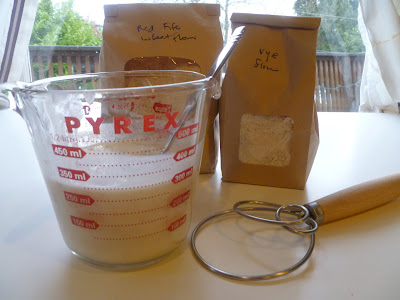With the holiday season in full force you may find yourself, as I did recently, with a crowd of guests to feed. My strategy was to cook up a couple pots of chili. One, a vegetarian bean chili, used up the last of my supply of heirloom beans from Lonesome Whistle Farm just in time for the start of their new CSA season (you can admire the variegated hues of Calypsos, Rio Zapes, Jacob's cattle, and Ireland Creek Annies above and read an interview with farmers Kasey and Jeff here). The other chili, for the carnivores in the crowd, was inspired by a recipe from the Homesick Texan.

The first step was to make a chile paste. This might seem like a lot of work, but it's actually quite easy and one gets to savor the fragrance of toasted spices while transforming a prosaic pile of dried chiles into a thick, exotic concoction. I followed a similar recipe to this one, with toasted garlic cloves, cumin and fennel seeds, cinnamon, cocoa powder, sun dried tomatoes, and a selection of dried chiles including milder anchos and negros, and spicier guajillos.
For the beef chili, I cooked up 4 slices of bacon and then browned 4 pounds of cubed beef chuck (from Long's) in the drippings. Then I sauteed some onions and red pepper, combined in half of my chile paste, the beef, I bottle of dark beer, and 1 cup of coffee, and cooked the whole pot, covered, in a low oven for 5 hours. I must admit to a moment of panic when I tasted the chili at the end of the day and found that it was extremely spicy (I'd used a lot of guajillos), but thankfully, the heat mellowed overnight and the chili was delicious the next day with a cool and crunchy slaw (sort of like this one, but with a buttermilk dressing).
For the bean chili, I combined the remaining chile paste with a can of tomatoes and simmered the bean pot along side the meat. This chili also had a hefty kick to it, but was tempered with a generous dollop of sour cream. We had plenty of food for a crowd and more to enjoy for family meals during the week.
Toasted chile paste
(enough for one of these chili recipes)
12 dried chiles (for medium spiciness use 4 anchos, 4 negros, and 4 guajillos; for more heat increase the proportion of guajillos)
12 sun dried tomato halves
1 Tbsp unsweetened cocoa powder
Heat a skillet and toast the chiles about one minute on each side until they puff up and become fragrant. Also heat the garlic cloves, still in their skins, until they start to blacken. When they are cool enough to handle, remove the stems and seeds from the chiles and immerse them in 2 cups hot water, along with the sun dried tomatoes. When the garlic cloves are done, peel them and put them in a blender. Toast the cumin and fennel seeds in the skillet until fragrant for about half a minute and add these to the blender, along with the cocoa powder, cinnamon, and salt. Spoon in the softened chiles and tomatoes. Add the soaking liquid, strained. Blend until you have a smooth paste.
Beef Chili
(Adapted from Homesick Texan, served 10-12)
4 thick slices of bacon
4 pounds cubed beef chuck
fresh ground pepper
salt
1 Tbsp canola oil
1 large onion, peeled and diced
1 red pepper, seeded and diced
1 recipe toasted chile paste (above)
1 cup coffee
1 bottle dark beer
2 Tbsp brown sugar
1. Heat a large Dutch oven and cook the bacon slices until the fat is rendered. Remove the bacon slices, dice and reserve.
2. Generously salt and pepper the cubed beef. Over medium heat, brown the cubed beef in the rendered bacon fat, working in batches so that you do not crowd the meat. Remove each batch to a plate.
3. Add a little canola oil if necessary and saute the onion until glassy. Add the diced pepper and saute another few minutes. Now add the chile paste and fry for a couple of minutes until fragrant. Then add back the beef with any accumulated juices, the diced bacon, and the coffee, beer, and sugar. Bring the pot to a simmer, cover, and transfer to a 250 degree oven.
4. Cook the chili for about 5 hours, stirring occasionally, until the meat has melted into buttery softness and the flavors have blended. if it looks dry at any time, add a little water. Toward the end, taste and add more brown sugar and salt if necessary. This is even better cooked a day ahead.
Vegetarian Bean Chili
(serves 10-12)
6 cups assorted dried beans, sorted and rinsed
2 Tbsp canola oil
1 recipe toasted chile paste (above)
1 32 ounce can tomatoes
1 Tbsp brown sugar
salt to taste
1. In a large Dutch oven, heat the canola oil. Add the chile paste and fry for a couple of minutes until fragrant. In the meantime, add the canned tomatoes to the blender jar and blend into a puree (and to make sure to dislodge all of the chile paste).
2. Add the blended tomato puree to the pot along with the beans and enough water to cover the beans by about an inch. Bring to a simmer.
3. Transfer to a 250 degree over and cook for about 4 to 5 hours until the beans are soft. While cooking stir occasionally and add a little more water if the bean pot is getting too dry. Toward the end of the cooking time, taste and add more brown sugar and salt if necessary.
Serve either chili with sour cream, diced avocado, chopped green onions, and cilantro.






























